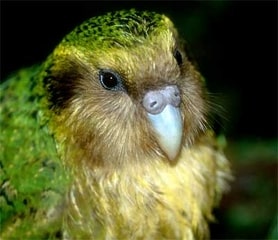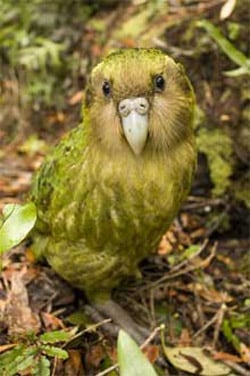The Kakapo (Strigops habroptilus) is a nocturnal parrot species belonging to the Strigopidae family. This solitary bird is sexually dimorphic in its body mass (males 1.6- 3.6 kg, females 0.9- 1.9 kg), and is the heaviest parrot species in the  world [1]. Adorned in a multitude of colours, the Kakapo’s green and yellow feathers allow it to blend in with its natural habitat; playing an essential role in camouflage due to its reversion to a primitive character state of being flightless [3]. However, the Kakapo’s beak possess vibrissae for navigation at night and large, rugged feet adapted to traversing through forest foliage. Its nocturnal nature and strikingly similar facial pattern colouration to owls, gained it the popular nickname “owl parrot” among it’s discoverers [1].
world [1]. Adorned in a multitude of colours, the Kakapo’s green and yellow feathers allow it to blend in with its natural habitat; playing an essential role in camouflage due to its reversion to a primitive character state of being flightless [3]. However, the Kakapo’s beak possess vibrissae for navigation at night and large, rugged feet adapted to traversing through forest foliage. Its nocturnal nature and strikingly similar facial pattern colouration to owls, gained it the popular nickname “owl parrot” among it’s discoverers [1].
Found exclusively in New Zealand, this parrot bird originally occupied a vast range of New Zealand and many of its surrounding maritime islands. Its excellent climbing ability allows it to thrive in both the canopy and along the forest floor; making its presence known with high pitched “skraak” calls [2]. However, European colonization and invasive predatory rodents drastically reduced its populations to isolated regions of New Zealand; areas unaffected by human interactions [4]. The Kakapo has almost entirely vanished from its natural geographical range; but has been re located to three predator free forest islands: Anchor, Codfish and Little Barrier [1].
The herbivorous nature of the Kakapo allows it to fill the important ecological niche of controlling vegetation density and seed dispersal [2]. It is known to feed on over 25 species of ferns,  shrubs, and herbs; in particular the Rimu Tree [5]. This flexible diet allows it to vary its feeding habits with seasonality. A majority of the Kakapo’s food gathering will transpire at night along the forest floor with its characteristic behavior of stripping plants/ seeds of their nutritious portions and leaving fibrous balls of plants material behind [5]. Its ability to avoid its natural bird of prey predators with its camouflage and nocturnal feeding made this species extremely successful prior to European colonization [6]. However, its slow running speeds and instinctive freezing when threatened has made it a easy food source for invasive predators of New Zealand such as: ferrets, weasels, stoats and feral cats [4].
shrubs, and herbs; in particular the Rimu Tree [5]. This flexible diet allows it to vary its feeding habits with seasonality. A majority of the Kakapo’s food gathering will transpire at night along the forest floor with its characteristic behavior of stripping plants/ seeds of their nutritious portions and leaving fibrous balls of plants material behind [5]. Its ability to avoid its natural bird of prey predators with its camouflage and nocturnal feeding made this species extremely successful prior to European colonization [6]. However, its slow running speeds and instinctive freezing when threatened has made it a easy food source for invasive predators of New Zealand such as: ferrets, weasels, stoats and feral cats [4].
The IUCN Red List of threatened species, currently lists the Kakapo as a critically endangered species [1]. Innately low rates of reproduction and a lack of adaptive defenses against invasive predators have almost entirely decimated the Kakapo; assistive rearing to overcome low fertility rates and protective relocation have been key in maintaining its survival [7]. The Kakapo is protected under the New Zealand Wildlife Act of 1953, as well as the establishment of the Kakapo Recovery Program managed by the New Zealand Department of Conservation. Since the 1990s, the department has played an instrumental role in the supplementary feeding, protection and propagation of this species [8].
The Kakapo Recovery Program has been extremely successful and well received by animal activist groups. The species population has gone from almost complete extinction to 124 living Kakapos, found living on predator free islands and copulating in the wild [8]. The current phase of the recovery plan is running from 2006-2016 with several primary intentions including: maintaining public awareness, minimizing population loss, and expanding populations to the levels of self-sustainability [9]. Continued efforts are being made to find other suitable habitats for Kakapo reintroduction, but invasive predators are always proving to be an obstacle. The final goal of the program is to be able to create self sustaining populations of Kakapo on the New Zealand mainland once again [9].
References
1. Powlesland, R.G., Merton, D.V., Cockrem, J.F. (2006). A parrot apart: the natural history of the kakapo (Strigops habroptilus), and the context of its conservation management. Notornis. 53 (1); 3–26.
2. Atkinson, I. A. E., Merton, D.V. (2006). Habitat and diet of kakapo (Strigops habroptilis) in the Esperance Valley, Fiordland, New Zealand. Notornis. 53;37–54.
3. Pyle, P. (2013). Evolutionary Implications of Synapomorphic Wing-Molt Sequences among Falcons (Falconiformes) and Parrots (Psittaciformes). Condor. 115 (3); 593–602.
4. Clout, M., Merton, D. (1998). Saving the Kakapo: the conservation of the world’s most peculiar parrot. Bird Conserv Int. 8; 281–296.
5. Best, H. A. (1984). The foods of Kakapo on Stewart Island as determined from their feeding sign. New Zeal J Ecol. 7; 71–83.
6. Gibbs, G. (2007). Ghosts of Gondwana; The history of life in New Zealand. Nelson: Craig Potton Publishing.
7. Department of Conservation. (n.d) Decline. Kakapo Recovery. Retrieved November 5, 2013, from http://kakaporecovery.org.nz/decline/.
8. Department of Conservation. (n.d) Turning the Tide. Kakapo Recovery. Retrieved November 5, 2013, from http://kakaporecovery.org.nz/turning-the-tide/.
9. Department of Conservation. (n.d) A Plan for the Future. Kakapo Recovery. Retrieved November 5, 2013, from http://kakaporecovery.org.nz/a-plan-for-the-future/.
